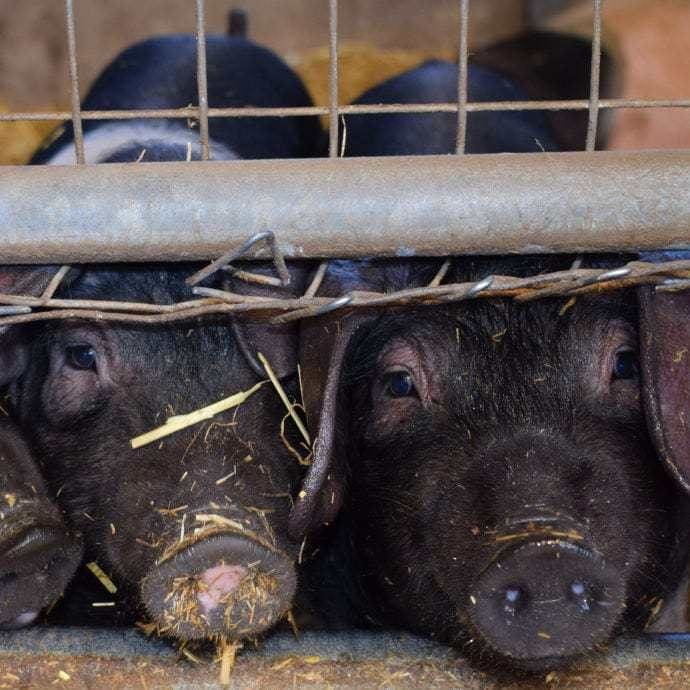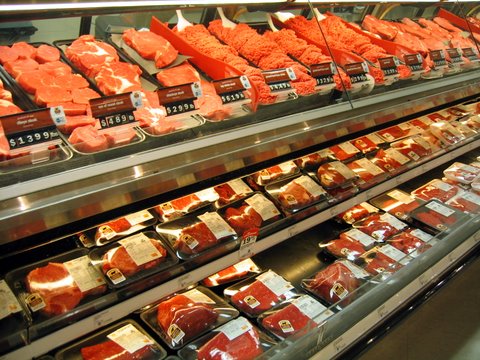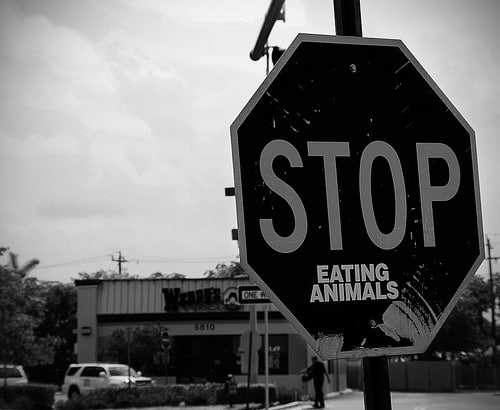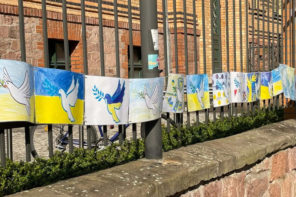Long-term vegetarian (and member of The Beatles) Paul McCartney famously observed that if slaughterhouses had glass walls, we would all become vegetarians. Part of the motivation behind Timothy Pachirat’s beautifully-painful, painfully-beautiful work is precisely to provide a much-needed window on the everyday violence that the vast majority of us in the industrialised world are in/directly connected to: meat.
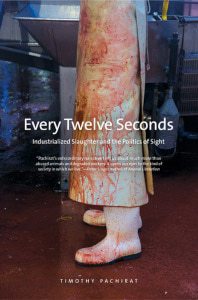
Pachirat spent nearly six months working in various capacities (from liver hanger, to animal prodder, to quality control inspector) in a slaughterhouse in Nebraska that ‘processes’ cattle: a fairly typical slaughterhouse in its slaughtering practices, it ‘processes’ twenty-five hundred cattle a day, or one every twelve seconds. Through careful documentation of what he saw, including meticulous floor plans of the slaughterhouse, which he would re-collect during the evenings after work (entering slaughterhouses under false pretense is a criminal offence worthy of hefty punishments), Pachirat provides “detailed accounts…which are not merely incidental to or illustrative of a more important theoretical argument about how distance and concealment operate as mechanisms of power in contemporary society. They are the argument” (p.19). One of the central motifs of his work is the manner in which sequestration and sight work symbiotically within the spaces of the slaughterhouse.
Pachirat makes rich use of Michel Foucault’s insights into our surveillance society.
In Jeremy Bentham’s late eighteenth-century designs for the ideal prison system, the Panopticon—with its central watchtower surrounded by backlit prison cells, which render prisoners constantly observable—the prisoners internalise the logic of the prison, and effectively regulate themselves. Foucault argues that this ideal of surveillance runs through prisons, hospitals, schools, and factories. With the revelations in 2013 by investigative journalist Glen Greenwald of comprehensive domestic and international surveillance by the NSA, we now know surveillance has entered our living rooms and bedrooms. In the slaughterhouse, surveillance makes workers continuously aware of the need to keep up with the inhuman (and inhumane) rate of processing animals. From the ‘chute’ where cows are forced into the machine by liberal use of electrical shocks, sometimes to their anuses (for all intents and purposes the slaughterhouse functions as a machine, and the various levels of workers, from the floor workers to the overseers, including USDA inspectors, are bound by the logic of meat production—efficiency—over all other considerations), to the strippers who rip hides from these recently beautiful creatures, dangling from their hind legs by chains (sometimes while still alive), to the liver hangers. It only takes forty-five minutes to reduce these “magnificent, awe-inspiring” animals (p.145) to two carcass halves.
Pachirat identifies four metrics that go into rendering these animals into beef products: 1) Linguistic: where the creatures are never referred to in terms that recognise their individual existence. For example, when animals collapse in the chutes from exhaustion, from slipping on faeces and vomit, thereby holding up the line, the workers announce it as “beef down”, and the necessary steps are taken to get the line moving again. 2) Physical: where the slaughterhouse is designed in such a way that it dis-locates the work of killing, so that workers (apart from ‘the knocker’, about whom I say more below) do not feel directly responsible for the killing. 3) Social: the slaughterhouse depends on an underclass of workers, quite often comprising ‘illegal immigrants’, who are in turn exploited in harsh working conditions, and with poor pay. 4) Methodological: this is a combination of the above three, and is embodied in the figure of the QC who, in addition to overseeing the quality of the meat—as far as acceptable levels of contamination from faeces and other waste—“assist[s] with the surveillance and control of bodies, both human and nonhuman, to enforce the discipline necessary for industrialized killing” (p.208).
To say a little more about the physical metric, which is the most illuminating: though the slaughterhouse employs over eight hundred people, only seven people have contact with the cattle while they are still alive. Of those seven only four are directly linked to the work of killing itself. Those four are known as the ‘knocker’, the ‘indexer”, the ‘presticker’ and the ‘sticker’. The knocker stands for nine to ten hours each day, and in the space of ten to twelve seconds for each cow, steer, or heifer, shoots a bolt into its forehead. The indexer spaces the animals, after they have been shot, on the overhead rail, and the presticker and sticker slice open the neck of the flailing animals and cut the carotid arteries and veins to bleed them out.
The actual work of killing is, from the very beginning, sequestered to only a handful of individuals out of a total workforce of over eight hundred.
Significantly, even the work of killing itself among those four workers is spatially fragmented: the knocker stands in one location where the cattle enter the kill floor. After he shoots the animals, they are hung from their hind legs and carried via overhead rails through a series of ninety degree turns that puts them behind a floor to ceiling wall, which takes them out of his line of sight where the sticker and presticker do their job. The work of killing is dis-located, and there is no definite location where the moment of death actually takes place. This gives rise to a fascinating relationship between the workers and their work, whereby only the knocker is imagined as killing the animals, even though all one hundred and twenty one of the workers on the kill floor are involved in the processing/killing of the animal. In Pachirat’s crystalline prose:
“Only the knocker places the hot steel gun against the shaking, furry foreheads of creature after creature, sees his reflection in their rolling eyes, and pulls the trigger that will eventually rob them of life: only the knocker. If you listen carefully enough to the hundreds of workers performing the 120 other jobs on the kill floor, this might be the refrain you hear: ‘Only the knocker.’ It is simple moral math: the kill floor operates with 120+1 jobs. And as long the 1 exists, as long as there is some plausible narrative that concentrates the heaviest weight of the dirtiest work on this 1, then the other 120 kill floor workers can say, and believe it, ‘I’m not going to take part in this. I’m not going to stand and watch this.’” (p.160).
The workers are themselves numbed by the speed of the machine of industrial slaughter, and, somewhat paradoxically, it is “[t]his numbness [that] can help the worker lose track of time, relieving the almost unbearable monotony of the line work” (p.217). Psychological dislocation from the type of work that is done—as far as the processing of the beef in all in its stages, from killing, to slicing, to dicing, and cleaning—is an essential component. It speaks to the underclass of society (comprised mainly of ‘illegal’ immigrants) that the slaughterhouse depends on, and, in turn, takes advantage of in order to sate our need for cheap meat.
In a remarkable final chapter, Pachirat argues for “a politics of sight that breaches zones of confinement” (p.255), “a world organized around the removal of physical, social, linguistic, and methodological distances” (p.254), taking inspiration from science fiction novelist Ursula Le Guin’s novel The Dispossessed (1974). However, beyond providing simple binaries such as “visible/invisible, plain/hidden, and open/confined” (p.253), Pachirat invites us to think critically about a “context-sensitive politics of sight that recognizes both the possibilities and pitfalls of organized, concerted attempts to make visible what is hidden and to breach, literally or figuratively, zones of confinement in order to bring about social and political transformation” (p.255).
The glass walls of Paul McCartney’s imagined slaughterhouse is not, in other words, itself sufficient.
For, who is to say that simply being made to see the violence (against animals, against civilians, against all manner of living bodies) may not itself become a source of pleasure and profit? (Stephen King’s 1982 novel, Running Man, which was made into a movie starring Arnold Schwarzenegger in 1987, and the more recent The Hunger Games trilogy of books and movies, come to mind.) Humans have had a long and complex relationship to violence—whether towards one another or towards animals—which is not, it would seem, going to be solved any time soon. Especially given that the military industrial complex is by far the biggest global industry, and which, as Pachirat strongly indicates, relies on the same four metrics as the meat industry. One cannot help but wonder if our hunger for nonhuman flesh is somehow—however remotely—connected to our seemingly insatiable appetite for human blood.
References
Collins, Suzanne. 2010. The Hunger Games Trilogy. New York: Scholastic Press.
Foucault, Michel. 1995. Discipline and Punish: The Birth of the Prison. New York: Random House.
King, Stephen. 1982. The Running Man. New York: Signet.
Le Guin, Ursula. 1974. The Dispossessed. New York: Harper and Row.
Schlosser, Eric. 2001. Fast Food Nation: The Dark Side of the All-American Meal. New York: Houghton Mifflin Company.
Pachirat, Timothy. 2013. Every Twelve Seconds: Industrialized Slaughter and the Politics of Sight. New Haven: Yale University Press. 320 pp. Pb: $22.00. ISBN: 9780300192483.

